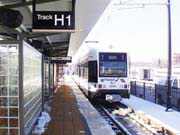While the terrorist attacks of Sept. 11, 2001 continued to have an emotional ripple effect nationwide this year, few areas felt the effects as strongly as Hudson County. The county is still finding ways to improve transportation services after the attacks, and there has definitely been progress.
The biggest Hudson County transportation story of 2002 was the opening of the Hudson-Bergen Light Rail station in Hoboken on Sept. 28. The 21.5-mile light rail train line now runs from 45th Street in Bayonne through Jersey City and to southern Hoboken, and will ultimately continue north into Bergen County.
Said Gov. Jim McGreevey at the opening ceremonies, "As this system continues to expand, more communities and residents will benefit from its quality service, connections with other transit services and improved access to jobs in the region."
According to Ken Hitchner, a spokesman for NJ Transit, the Hoboken station, located at the city’s southern border, completes the first segment of the line from Bayonne through Jersey City. This station connects the system with NJ Transit, private carrier buses, NJT commuter rail service, PATH service, and New York Waterway ferry service. It is the 16th station in the project.
The second phase is already under construction. This is a six-mile, seven-station line that will run north over Hoboken’s west side through Weehawken, Union City and North Bergen. This segment will be completed in 2005. The part of it running from Hoboken to Weehawken Ferry Terminal will be completed in 2004. The Weehawken Ferry Terminal to Tonnelle Avenue, North Bergen section, will be completed in 2005.
According to Hitchner, the original plan for the third segment called for the light rail to eventually wind up at the Vince Lombardi Park and Ride in Ridgefield, thereby technically fulfilling the "Bergen" part of the light rail’s name. But now, said Hitchner, "there are other things being studied." Hitchner said that one of the ideas being looked at is the extension of the line as far north as Tenafly, in northern Bergen County.
2002 statistics show that the Hudson-Bergen Light Rail completed 16,200 "trips" on a daily basis. A "trip" is one person riding the light rail between two stops. If a person was to take the light rail from Jersey City to Hoboken and then return from Hoboken back to Jersey City, that would be considered two "trips."
Since Sept. 11, there has been a fundamental shift in the area’s transportation focus. In December, 2001, the Port Authority set aside $550 million to restore PATH service from Jersey City and Hoboken to Manhattan’s financial district by this year.
But without underground service and with an infusion of an estimated 32,000 new daily passengers to Jersey City because of the attacks, a newfound emphasis has been placed on the area’s ferry service between the Hudson waterfront and Manhattan.
Nine new ferries have been added in the last year. Six are "9/11"-themed, and the other three are: the Hoboken, the Brooklyn and the Sen. Frank Lautenberg. The fleet now boasts 33 NY Waterway ferries and 21 additional chartered ferries that NY Waterway has leased while waiting for new ferries. According to NY Waterway spokesperson Pat Smith, the ferries made 65,000 daily trips in 2002, which translates to 30,000 people making two trips per day. Over the last year and a half, ferry use increased almost 50 percent. To answer this demand, NY Waterway added new weekend ferry service from Hoboken at 13th Street and from Newport in Jersey City to Chelsea Piers in Manhattan.
NY Waterway has also added two new routes from Hoboken to lower Manhattan: Hoboken to Pier A at Battery Park and Hoboken to Pier 11 at Wall Street. The company has also restored service to the World Financial Center, which had been interrupted by the 9/11 attacks.
On the flip side of the transportation coin, the Secaucus Transfer train station, which, in 2000, was a year ahead of schedule, has since fallen behind schedule by almost two years. This prompted pressure from Sen. Robert Torricelli, who has been instrumental in pouring federal money into the project.
The train station is tentatively scheduled to open in September, 2003.
The delay has not, however, hurt prospects for Allied Junction, the vast commercial element of the station. It will include six 40-story towers with about 4.7 million square feet of rental space slated to be constructed on top of the station. This phase of the project could wait until they find tenants for the commercial element to begin construction, said Marc Joseph, spokesperson for Allied Junction.
"According to our contract with NJ Transit, Allied Junction has eight years to begin construction after the train station begins public operations," Joseph said. "We are moving ahead as planned."
